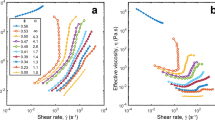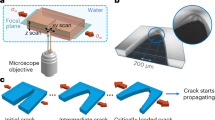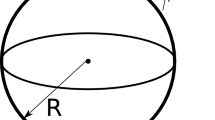Abstract
The formation of irregular (often fractal1) patterns under non-equilibrium conditions has become a subject of considerable scientific and practical interest. One of the most important processes of this type is the formation of cracks and other extended defects in materials under stress2,3. Here we present an experimental study of crack growth in a two-dimensional system, using a monolayer of uniformly sized microspheres confined between two parallel sheets of glass. The cracking patterns observed in this system closely resemble those found in more complex systems of practical importance, such as paint films or ceramic-coated metals. A simple two-dimensional computer model for elastic fracture leads to structures that closely resemble those observed in the experiments. In both the experimental and computer models an early stage in which isolated defects are formed is followed by a period in which rapid growth of almost linear cracks occurs. At later times the crack growth process slows down and the shapes of the cracks become increasingly irregular.
This is a preview of subscription content, access via your institution
Access options
Subscribe to this journal
Receive 51 print issues and online access
$199.00 per year
only $3.90 per issue
Buy this article
- Purchase on Springer Link
- Instant access to full article PDF
Prices may be subject to local taxes which are calculated during checkout
Similar content being viewed by others
References
Mandelbrot, B. B. The Fractal Geometry of Nature (W. H. Freeman and Company, New York, 1982).
Chemistry and Physics of Fracture (eds Latanison, R. M. & Jones, R. H.) NATO ASI Series E130 (Martinus Nijhoff, 1987).
Atkins, A. G. & Mai, Y. W. Elastic and Plastic Fracture: Metals, Polymers, Ceramics, Composites, Biological Materials (Ellis Harwood, Chichester, 1983).
Ugelstad, J. et al. Adv. Colloid & Interface Sci. 13, 101–140 (1980).
Meakin, P. Thin Solid Films 151, 165–190 (1987).
Mandelbrot, B. B., Passoja, D. E. & Paullay, A. J. Nature 308, 721–722 (1984).
Avnir, D., Farin, D. & Pfeiffer, P. Nature 308, 261–263 (1984).
Louis, E. & Guinea, F. Europhys. Lett. 3, 871–877 (1987).
Termonia, Y. & Meakin, P. Nature 320, 429–431 (1986).
Niemeyer, L., Pietronero, L. & Wiesmann, H. J. Phys. Rev. Lett. 52, 1033–1036 (1984).
Nittmann, J., Daccord, G. & Stanley, H. E. Nature 314, 141–144 (1985).
Van Damme, H., Obrecht, F., Levitz, F., Gatinuea, P. & Laroche, C. Nature 320, 731–733 (1986).
Witten, T. A. & Sander, L. M. Phys. Rev. Lett. 47, 1400–1403 (1981).
Jackson, W. D. Classical Electrodynamics (Wiley, New York, 1962).
England, A. H. Complex Variable Methods in Elasticity (Clowes, London, 1971).
Voss, R. F. in Scaling Phenomena in Disordered Systems (eds Pynn, R. & Skjeltorp, A. T.) 1–11 (Plenum, New York, 1986).
Meakin, P. in Phase Transitions and Critical Phenomena Vol. 12 (eds Domb, C. & Lebowitz, J. L.) 336–489 (Academic, New York, 1988).
Author information
Authors and Affiliations
Rights and permissions
About this article
Cite this article
Skjeltorp, A., Meakin, P. Fracture in microsphere monolayers studied by experiment and computer simulation. Nature 335, 424–426 (1988). https://doi.org/10.1038/335424a0
Received:
Accepted:
Issue Date:
DOI: https://doi.org/10.1038/335424a0
This article is cited by
-
A spring network simulation in three dimensions for designing optimal crack pattern template to fabricate transparent conducting electrodes
Bulletin of Materials Science (2019)
-
Role of particle shape anisotropy on crack formation in drying of colloidal suspension
Scientific Reports (2016)
-
Cracking-assisted photolithography for mixed-scale patterning and nanofluidic applications
Nature Communications (2015)
-
Particle dynamics modeling methods for colloid suspensions
Computational Particle Mechanics (2014)
-
Patterning by controlled cracking
Nature (2012)
Comments
By submitting a comment you agree to abide by our Terms and Community Guidelines. If you find something abusive or that does not comply with our terms or guidelines please flag it as inappropriate.



